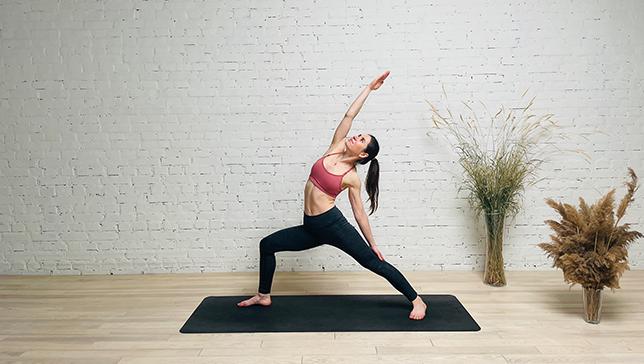Peaceful Warrior Pose - Shanti Virabhadrasana

Contents
The Peaceful Warrior Pose, also known as Reverse Warrior Pose or Shanti Virabhadrasana (SHAN-tee VEER-ah-bhah-DRAH-sah-nah), is a powerful lunge combined with a graceful backbend. It is often utilized as a transitional pose or to seamlessly connect other postures in a vinyasa practice.
The name of this pose originates from Sanskrit, with “shanti” meaning “peace,” “vira” representing “hero,” “bhadra” symbolizing “friend,” and “asana” denoting “pose” or “posture.”
Shanti Virabhadrasana offers numerous benefits, including improved flexibility in the back, strengthened legs, feet, and abdominal muscles, hip opening, elongation of the arms, torso, and spine. When practiced mindfully, it can also aid in relieving back pain.
Pose Detail
- Body Position: Backbend Yoga Poses, Standing Yoga Poses
- By Type: Balancing Yoga Poses, Chest Opening Yoga Poses, Flexibility Yoga Poses, Hip Opening Yoga Poses, Strengthening Yoga Poses
- Difficulty: Beginners
Step-by-Step Instructions
Benefits and Contraindications
Improves the flexibility in the spine
Stretches the side of the upper body
Opens heart and smoothens the hips
Strengthens the leg muscles
Calms the nervous system
Improves balance
Knee or back injury
Neck issues
Balance difficulties
Photo poses in different angles

Modifications and Props for Beginners
Peaceful Warrior Pose is a great way to add flexibility to the spine and prepare the body for many other poses throughout your practice. Remember to take it slowly and never push your body to achieve a deeper backbend. Try these simple changes in the pose to find a variation that works for you:
- If your hips are tight, shorten your stance and straighten your front leg to a degree that is comfortable as you work on gaining flexibility.
- If you have a shoulder injury or if you are still building upper body strength, place your hands on your hips. Work on lifting your chest and lengthening your spine without over-straining your arms and shoulders.
Useful Tips
- For beginners, keep your back hand on the upper thigh.
- The more open you become in the side body, you can begin to move your back hand down the back leg.
- Avoid placing your hand directly on to the back knee.
Frequently Asked Questions
You can hold the pose for as long as it feels comfortable, typically around 30 seconds to 1 minute. Repeat on the other side.
Yes, beginners can do this pose, but they may need to modify it by using a block or placing their hand on their hip for support. It’s important to work within your own range of motion and not push too far beyond your limits.
If you have any injuries or medical conditions that affect your knees, hips, or shoulders, it’s important to talk to your doctor or a qualified yoga instructor before attempting this pose. You should also avoid this pose if you have any pain or discomfort in your knees or hips. Always work within your own range of motion and listen to your body.